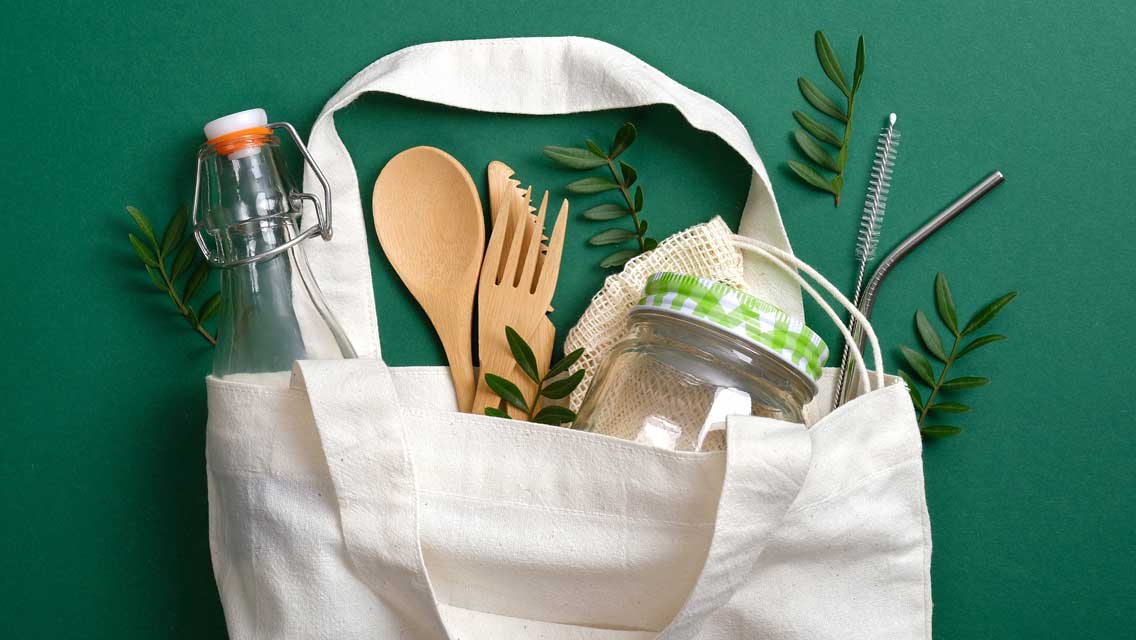In 2005 Bea Johnson and her family were living in a remote suburb of San Francisco. They owned a 3,000-square-foot house with two large refrigerators and a three-car garage when they decided to relocate to Mill Valley, a walkable town across the bay full of cafés, bakeries, and bookstores.
During the house hunt, they put most of their belongings in storage and lived in a rental — and were surprised by how much they enjoyed living with less stuff. They eventually bought a home less than half the size of their previous one and gradually jettisoned most of what they owned. Within a couple of years, they had sold or donated 80 percent of their belongings.
“Since we no longer spent every weekend mowing our lawn and caring for a huge house and its contents, we now spent our time together as a family — biking, hiking, picnicking, and discovering a new coastal region,” Johnson recalls. “It was liberating.”
Meanwhile, Johnson and her husband, Scott, began studying the effects of overconsumption on the planet. The more they learned — that the average American tosses out four pounds of trash per day, for instance — the worse they felt. “We felt bad as parents leaving a crappy world for our children,” she says.
So they decided to act. Scott quit his corporate job and launched a sustainability consulting company. Bea took their downsizing a step further. She wanted to completely stop producing household waste, including unworn clothing, and reduce their use of resources like electricity.
It sounds impossible, but after years of trial and error, the Johnson family now produces about one pint of garbage per year. And while it would seem like they must feel deprived, they’re actually happier.
“Our life is based on experiences instead of things,” Johnson says. “It’s based on being instead of having, and that is really what makes life richer.”
Johnson has since written a book based on their experience, Zero-Waste Home: The Ultimate Guide to Simplifying Your Life by Reducing Your Waste.
Still, a person doesn’t have to cut her garbage to a pint a year to make a positive impact. If every U.S. household used just three fewer rolls of paper towels per year, for example, it would keep 120,000 tons of paper waste out of landfills. If we used only one less roll, we’d save 544,000 trees.
And there’s a whole lot more we can do to reduce our footprints. Johnson’s “5-Rs” approach to living with less — refuse, reduce, reuse, recycle, and rot — offers some good starting points.
1. Refuse
The first step to reducing waste, Johnson says, is to refuse to bring unnecessary stuff home. “The more you refuse, the less you have to reduce. The more you reduce, the less you’ll have to reuse.”
Because marketers are skilled at convincing people they need something, refusing can be difficult, says Kathryn Kellogg, author of 101 Ways to Go Zero Waste. She recommends creating a plan for when you feel pressured — a way to buy time to consider whether you really need something.
Kellogg avoids impulse buys by waiting 30 days before purchasing anything that’s not an obvious necessity. And because she puts so much thought into the process, she appreciates the goods even more.
Johnson believes that no item is too small to refuse — including business cards and takeout menus. We often accept these out of politeness, but it’s possible to be polite without taking home needless stuff. She offers these two tips for saying no:
Pause and consider, whether it’s a hand-me-down sweater from a friend or an appealing swag bag at an event. “Stop a moment and ask yourself, ‘Do I really need this?’” Johnson advises. She’s amazed by how much stuff she’s kept out of her home simply by pausing.
Prepare a friendly stock response to offers of free things. This allows you to honor others’ generosity and your intention to simplify. Johnson suggests: “It’s very nice of you, but I don’t need one” or “No, thanks; I’m a minimalist.”
Other refusing tips:
- Adopt your own waiting period for purchases to determine if you really need them.
- Carry a reusable mug for coffee and tea to go.
- Skip the straw. (If you love them, get a metal or bamboo one and carry it with you.)
- Instead of accepting flyers or business cards, take photographs of them with your phone.
- Use the library for books you’ll read only once.
- Visit the website for the Data and Marketing Association (dmachoice.thedma.org) and opt out of multiple junk-mail categories.
- Go paperless for your finances. Receive and pay your bills online; request electronic bank statements.
- Keep a running list of needed items on your phone or calendar. Consult it before buying anything.
|
2. Reduce
An easy way to reduce waste is to break bad habits, like leaving the lights on in an empty room. Americans typically waste 283 kilowatt hours of energy each month — the equivalent of running an oven at 350 degrees F for six days straight. Hitting a switch is nearly effortless.
Johnson’s family saves on electricity because they painted the interior of their house white. It was meant to be a symbolic fresh start, she says; then they found that the color scheme had a huge impact on their electricity bill. “When it gets dark, the neighbors have their lights on, and we don’t because our interior stays bright longer.”
Decluttering your home is another great way to reduce waste. When things are in their proper places, you’ll know what you have and what you need. “How many times have you bought Band-Aids, only to discover a whole unopened box at home?” asks professional organizer Felice Cohen, author of 90 Lessons for Living Large in 90 Square Feet (. . . or More).
When Cohen declutters a client’s home, she organizes items by category: office supplies with office supplies, winter clothes with winter clothes. This makes it easier to know where “home” is for any particular object and to recognize when something might be missing.
Decluttering your refrigerator and pantry can also reduce waste. Americans toss 150,000 tons of food each day, or the equivalent of 1 pound per person. “Learn to let your fridge go empty,” suggests zero-waste advocate Lauren Singer in her blog, Trash Is for Tossers. “Don’t buy new food until you’ve eaten almost everything that’s perishable.”
This may require an adjustment in how you plan meals, Singer notes. “Rather than thinking about what you want to eat and buying food based on that, look at what you currently have and figure out what you can make with it.”
Other reducing tips:
- Plan meals before you go to the grocery store and shop for those meals only.
- Buy unpackaged whole foods.
- Bring your own bags and jars to the grocery store for bulk items.
- Bring your own takeout containers to restaurants.
- Turn off lights when you leave a room.
- Turn off the faucet while brushing teeth or washing your face.
- Wash clothes less often, and when you do, wash in cold water; it uses 90 percent less energy than hot.
- Walk, ride a bike, or take public transportation instead of your car whenever possible to save gas and reduce carbon emissions.
- Carpool to work and events.
|
3. Reuse
We often throw away objects that could easily have a second life. A lidless Tupperware container can be a great storage option for kids’ crayons, Cohen notes. A moth-eaten sweater or old pillow might become the perfect materials for a new cat bed.
Meanwhile, single-use items are largely unnecessary; there’s almost always a reusable version. “We swapped the paper towels for rags, the tissues for handkerchiefs — there’s a reusable alternative for anything that’s disposable,” says Johnson. There are even reusable filters now for those notoriously wasteful coffee pods.
Finally, buying secondhand items is an economical way to avoid contributing to the wasteful production cycle.
Even though he’s a designer himself, Joshua Katcher, author of Fashion Animals and owner of the clothing brand Brave Gentleman, suggests buying most clothes secondhand. “Go to thrift stores. Go to secondhand shops. Go to vintage shops. If you can commit to making that 80 percent of your wardrobe, that’s a huge elimination of textile waste.”
And don’t forget about repairing things, whether that’s an item of clothing, a coffee mug, or an iPhone. “Reusing is great because it has so many different meanings,” Kellogg says. “It’s about making things last as long as possible.”
Other reusing tips:
- Carry a reusable water bottle. (And bring along this tiny portable filter for tap water: www.gopurepod.com.)
- Keep a tote bag handy to use instead of stores’ bags.
- Treat yourself to some cloth napkins you’ll enjoy using.
- Use Craigslist, eBay, and Facebook Marketplace to shop for specific secondhand items.
- Cut old towels and T-shirts into rags for cleaning.
- Replace disposable razors with a straight razor or rechargeable electric razor.
- Avoid disposable wipes when a washcloth will do.
- Save and reuse the glass jars from coconut oil, peanut butter, and so on.
- If you have a pod coffeemaker, get a reusable filter at www.keurig.com/content/reusable-coffee-filter.
|
4. Recycle
Recycling is a valuable strategy, but it isn’t a perfect approach to waste reduction. The recycling process requires its own portion of energy and resources, and some preparation is necessary to ensure items make it to recycling centers.
Textile waste, for example, is a major problem — only about 15 percent of unwanted clothing is donated or recycled; 193,000 tons goes to landfills each year.
But some retailers are working to address the issue and make it easier for customers to keep their clothes out of garbage dumps. Patagonia, Nike, H&M, and other retailers will recycle worn-out purchases and sometimes offer in-store credit for these returns. (For more on textile waste, see “6 Ways to Quit Fast Fashion.”)
When it comes to clothes in good condition that you’re no longer wearing, donating them to the Salvation Army or other charitable organizations is a way to give them a second life.
Other recycling tips:
- Keep a recycling bin next to your garbage can.
- Visit your local waste-management facility’s website to learn the sorting protocol for your area. Recycling rules and availability vary by state, county, and city.
- Rinse containers well; they must be clean to be processed.
- Add cardboard pizza boxes to your compost pile. They’re hard to recycle but easy to compost.
- If your municipality doesn’t offer single-stream recycling, use a container with dividers so it’s quicker to take out on recycling day.
- Donate old bedding to animal-rescue organizations, which are always looking for soft items to keep the animals warm.
|
5. Rot
About 30 percent of what Americans discard will decompose, so composting can cut your waste without a lot of effort. The process sounds intimidating, but it can be easy, whether you live in a house with a yard or an apartment with no outdoor space. Here’s how:
For backyards: Buy an enclosed bin to keep critters out, or build one with chicken wire. Mix wet scraps with about half dry material (leaves, yard waste) and turn it weekly to help materials decompose. Use the compost to fertilize your garden or potted plants. (Learn more at “How to Start Composting.”)
For apartments: A growing number of cities collect compostable scraps at the curb. If yours doesn’t, you can save compost in a freezer container (like this one, for example: www.fullcirclehome.com/products/scrap-happy) and take it to a designated community garden. For drop-off spots across the United States, visit www.litterless.co/wheretocompost. You can also pay for a composting service.
Electronic Waste
“E-waste is the fastest-growing municipal-waste stream in the world,” cautions Kathryn Kellogg, author of 101 Ways to Go Zero Waste.
She advises finding a certified e-waste dealer that guarantees your discarded phones and laptops will be processed stateside. Otherwise, she says, these items may end up in another country without stringent waste regulations, where they’ll likely be mined for their metals. The remaining components are usually discarded and left to leach into the groundwater, posing dangers to those workers, citizens, and ecosystems.
Kellogg offers these tips for reducing e-waste:
- Don’t fall prey to unnecessary upgrades.
- If an item is still working, clear all your data and sell the device on Craigslist or a similar site.
- Donate old phones or laptops to one of the many organizations that can use them. Recycling for Charities (www.recyclingforcharities.com) allows you to donate a phone and choose the charity you’d like to support.
The challenge of reducing one’s waste can feel overwhelming, but it doesn’t have to be. Just do what you can, when you can, and remember that we all reach every destination thanks to a series of small steps.
This originally appeared as “Living Small” in the April 2019 print issue of Experience Life.




This Post Has 0 Comments